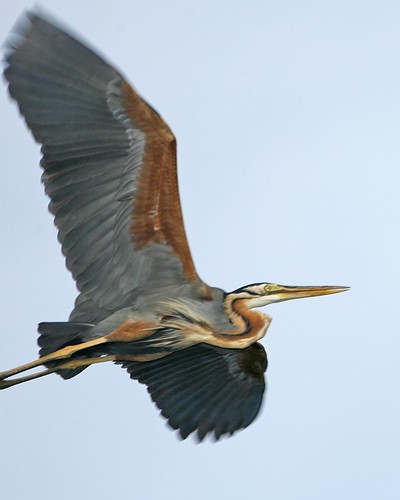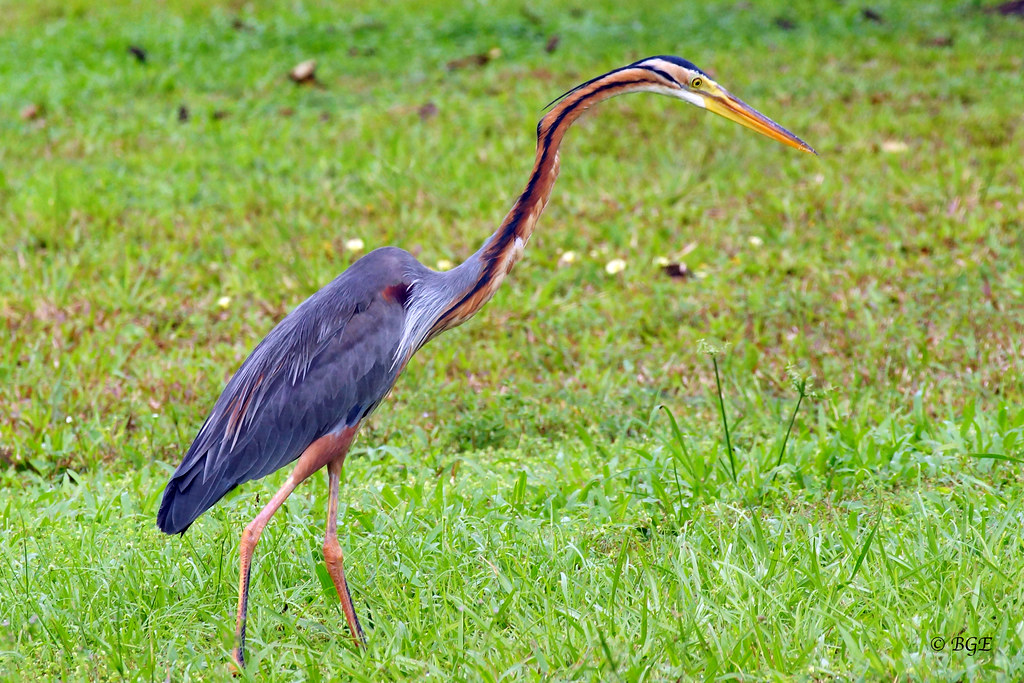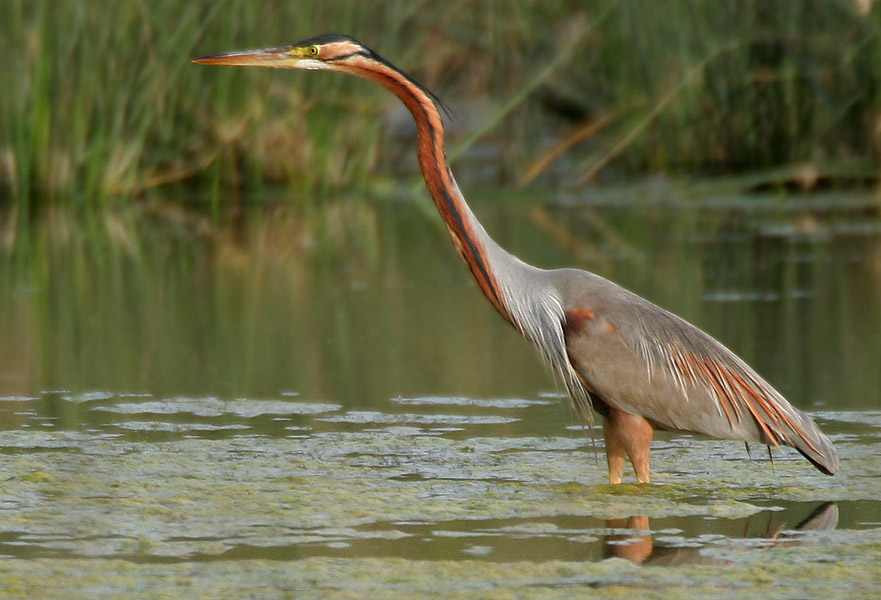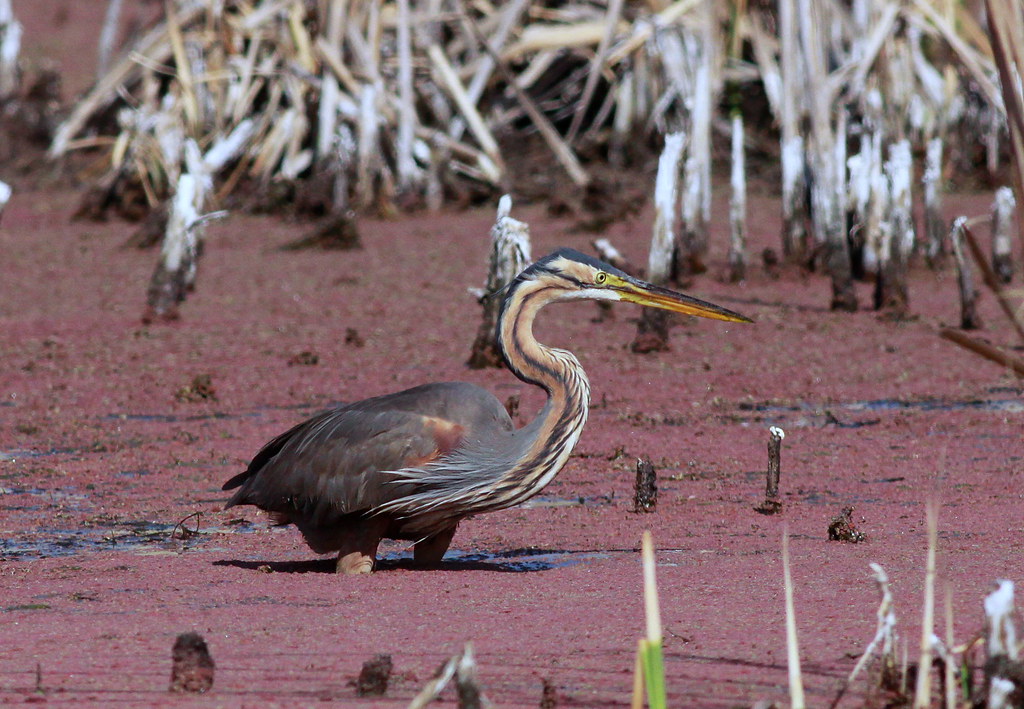Purple heron
Ardea purpurea
A migratory guest that makes its way from the distant, tropical shores of Africa, the purple heron arrives in the Danube Delta during spring for the mating season. It stays from March to the beginning of September.
This bird is slender, weighing between 0.5 and 1.3 kg, and stands between 70 -90 cm in height. When it soars to the sky, you may admire its wings that are about 120- 150cm in total. More colorful than their grey relatives, they present themselves with fancy striped necks in tones of rusty-brown, while their backs a dark gray, with the occasional red feather. Their eyes are a bright yellow, while their beaks and legs are orange and brown.
This bird is very private and usually lives out of view among the reeds. Its light weight allows it to walk around gently even on floating vegetation. It feeds mostly on frogs and insects, hunting in areas with low water.

Photographer: Lip Kee

Photographer: Derek Keats
Oaspete migrator ce își croiește drumul de pe țărmurile îndepărtate și tropicale ale Africii, stârcul roșu sosește în Delta Dunării în timpul primăverii pentru sezonul de împerechere. Stă aici din martie până la începutul lunii septembrie.
Această pasăre zveltă, are o greutate cuprinsă între 0,5 și 1,3 kg și o înălțime între 70 și 90 cm. În zbor pot fi admirate aripile sale mari, cu o anvergură de aproximativ 120-150 cm. Mai colorați decât frații lor cenușii, aceștia prezintă gâturi lungi, elegant dungate în tonuri de maro ruginiu, în timp ce spatele lor este gri închis, cu ocazionale pene roșii. Ochii lor sunt un galben viu, în timp ce ciocurile și picioarele lor sunt portocalii și maro.
Această pasăre este foarte sfioasă și de obicei trăiește ascunsă printre stufărișuri. Greutatea redusă le permite să se deplaseze ușor chiar și pe vegetația plutitoare. Vânează de obicei în zone cu apă mică, unde se hrănesc în mare parte cu broaște și insecte.
Stârc roșu
Ardea purpurea
Purpurreiher
Ardea purpurea
Der Purpurreiher ist ein Zugvogel, der von den fernen, tropischen Küsten Afrikas kommt und im Frühjahr zur Paarungszeit im Donaudelta eintrifft. Er bleibt von März bis Anfang September.
Der schlanke Vogel wiegt zwischen 0,5 und 1,3 kg und ist zwischen 70 und 90 cm groß. Wenn er sich in den Himmel erhebt, kann man seine Flügel bewundern, die insgesamt 120 bis 150 cm lang sind.
Sie sind farbenfroher als ihre grauen Verwandten und präsentieren sich mit ausgefallen gestreiften Hälsen in rostbraunen Tönen, während ihr Rücken dunkelgrau ist und gelegentlich rote Federn aufweist. Ihre Augen sind leuchtend gelb, während Schnabel und Beine orange und braun sind.
Dieser Vogel ist sehr scheu und lebt meist versteckt im Schilf. Durch sein geringes Gewicht kann er sich auch auf schwimmender Vegetation leicht fortbewegen. Er ernährt sich hauptsächlich von
Fröschen und Insekten und jagt in Gebieten mit niedrigem Wasserstand.

Photographer: J M Garg

Photographer: Derek Keats
Un oiseau migrateur qui fait son chemin depuis les lointaines côtes tropicales de l’Afrique, le héron pourpré arrive dans le delta du Danube au printemps pour la saison des amours. Il reste de mars à début septembre.
Cet oiseau est mince, pèse entre 0,5 et 1,3 kg et mesure entre 70 et 90 cm de hauteur. Lorsqu’il s’envole vers le ciel, vous pourrez admirer ses ailes qui mesurent environ 120-150 cm au total. Plus colorés que leurs parents gris, ils se présentent avec des cous rayés fantaisie dans des tons de brun rouille, tandis que leur dos est gris foncé, avec parfois une plume rouge. Leurs yeux sont d’un jaune vif, tandis que leur bec et leurs pattes sont orange et marron.
Cet oiseau est très discret et vit généralement à l’abri des regards parmi les roseaux. Son poids léger lui permet de se promener en douceur même sur de la végétation flottante. Il se nourrit principalement de grenouilles et d’insectes, chassant dans les zones où l’eau est basse.
Héron pourpré
Ardea purpurea
Try using these colors:
Remember, there are always more colors than you think you see!







